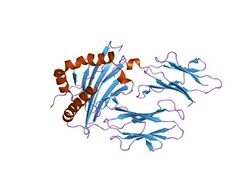Biology:Group II pyridoxal-dependent decarboxylases
From HandWiki
Short description: Class of enzymes
| Pyridoxal-dependent decarboxylase conserved domain | |||||||||
|---|---|---|---|---|---|---|---|---|---|
 crystal structure of the murine class ii allele i-a(g7) complexed with the glutamic acid decarboxylase (gad65) peptide 207-220 | |||||||||
| Identifiers | |||||||||
| Symbol | Pyridoxal_deC | ||||||||
| Pfam | PF00282 | ||||||||
| Pfam clan | CL0061 | ||||||||
| InterPro | IPR002129 | ||||||||
| PROSITE | PDOC00329 | ||||||||
| SCOP2 | 1js3 / SCOPe / SUPFAM | ||||||||
| |||||||||
In molecular biology, group II pyridoxal-dependent decarboxylases are family of enzymes including aromatic-L-amino-acid decarboxylase (L-dopa decarboxylase or tryptophan decarboxylase) EC 4.1.1.28, which catalyses the decarboxylation of tryptophan to tryptamine, tyrosine decarboxylase EC 4.1.1.25, which converts tyrosine into tyramine and histidine decarboxylase EC 4.1.1.22, which catalyses the decarboxylation of histidine to histamine.[1][2]
Pyridoxal-5'-phosphate-dependent amino acid decarboxylases can be divided into four groups based on amino acid sequence. Group II includes glutamate, histidine, tyrosine, and aromatic-L-amino-acid decarboxylases.[3]
See also
- Group I pyridoxal-dependent decarboxylases
- Group III pyridoxal-dependent decarboxylases
- Group IV pyridoxal-dependent decarboxylases
References
- ↑ "Functionally important residues of aromatic L-amino acid decarboxylase probed by sequence alignment and site-directed mutagenesis". J. Biochem. 120 (2): 369–76. August 1996. doi:10.1093/oxfordjournals.jbchem.a021422. PMID 8889823.
- ↑ "Characterization and expression of the complementary DNA encoding rat histidine decarboxylase". Proc. Natl. Acad. Sci. U.S.A. 87 (2): 733–7. January 1990. doi:10.1073/pnas.87.2.733. PMID 2300558. Bibcode: 1990PNAS...87..733J.
- ↑ "Multiple evolutionary origin of pyridoxal-5'-phosphate-dependent amino acid decarboxylases". Eur. J. Biochem. 221 (3): 997–1002. May 1994. doi:10.1111/j.1432-1033.1994.tb18816.x. PMID 8181483.
 |

